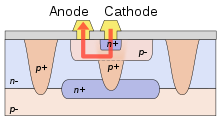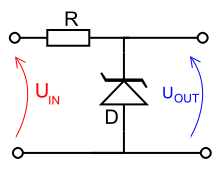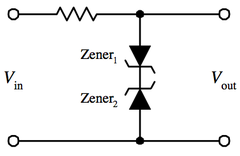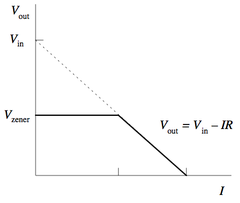Zener diode
| |||||||||||||||
Read other articles:

Village on Strangford Lough, Northern Ireland For the constituency, see Killyleagh (Parliament of Ireland constituency). For the village in County Armagh, see Killylea. Human settlement in Northern IrelandKillyleaghIrish: Cill Ó LaochKillyleagh Harbour and St. John's ChurchKillyleaghLocation within County DownDistrictNewry, Mourne and DownCountyCounty DownCountryNorthern IrelandSovereign stateUnited KingdomPost townDOWNPATRICKPostcode districtBT30PoliceNorthern IrelandFireNorthern Ire…

State forest in California Mountain Home Demonstration State ForestLocationTulare County, CaliforniaNearest citySpringville, CaliforniaCoordinates36°13′51″N 118°42′46″W / 36.230954°N 118.712892°W / 36.230954; -118.712892Area4,807 acres (19 km2)Established1946Governing bodyCalFire Mountain Home Demonstration State Forest (MHDSF) is a state forest located on Bear Creek Road (Tulare County Route 220), 28 km (17 mi) northeast of Springvill…

この記事は検証可能な参考文献や出典が全く示されていないか、不十分です。出典を追加して記事の信頼性向上にご協力ください。(このテンプレートの使い方)出典検索?: コルク – ニュース · 書籍 · スカラー · CiNii · J-STAGE · NDL · dlib.jp · ジャパンサーチ · TWL(2017年4月) コルクを打ち抜いて作った瓶の栓 コルク(木栓、蘭&…

Norwegian botanist Ove in the 1930s Ove Fredrik Arbo Høeg (25 November 1898 – 7 July 1993) was a Norwegian botanist. Personal life Høeg was born in Larvik as a son of consul Thomas Arbo Høeg (1852–1930) and Sigrid Bugge (1862–1945). His first marriage was to physician's daughter Elisabeth Cathrine Blom (1898–1927) from July 1923. After her death Høeg married dean's daughter Ellen Susanne Fridrichsen (1900–1955) in April 1934. During this marriage he was a brother-in-law of Anto…

Флаг гордости бисексуалов Бисексуальность Сексуальные ориентации Бисексуальность Пансексуальность Полисексуальность Моносексуальность Сексуальные идентичности Би-любопытство Гетерогибкость и гомогибкость Сексуальная текучесть Исследования Шка�…

Державний комітет телебачення і радіомовлення України (Держкомтелерадіо) Приміщення комітетуЗагальна інформаціяКраїна УкраїнаДата створення 2003Керівне відомство Кабінет Міністрів УкраїниРічний бюджет 1 964 898 500 ₴[1]Голова Олег НаливайкоПідвідомчі орг�…

若纳斯·萨文比Jonas Savimbi若纳斯·萨文比,摄于1990年出生(1934-08-03)1934年8月3日 葡屬西非比耶省Munhango(葡萄牙語:Munhango)逝世2002年2月22日(2002歲—02—22)(67歲) 安哥拉莫希科省卢库塞效命 安哥拉民族解放阵线 (1964–1966) 争取安哥拉彻底独立全国联盟 (1966–2002)服役年份1964 – 2002军衔将军参与战争安哥拉独立战争安哥拉內戰 若纳斯·马列罗·萨文比(Jonas Malheiro Savimbi,1934…

English footballer Bert Bellamy Bellamy while with Brentford in 1926.Personal informationFull name Herbert Bellamy[1]Date of birth (1896-04-07)7 April 1896Place of birth Kettering, EnglandDate of death 16 November 1978(1978-11-16) (aged 82)[2]Place of death Grimsby, EnglandPosition(s) Wing halfYouth career Kettering Fuller Institute0000–1919 Kettering White CrossSenior career*Years Team Apps (Gls)1919–1921 Kettering 1921–1923 Watford 36 (2)1923–1926 Swansea Town 90 (…

CheolindoNa Woon-gyu pada Cheolindo (1930)Nama lainHangul철인도 Hanja鐵人都 Alih Aksara yang DisempurnakanCheolindoMcCune–ReischauerCh'ŏrindo SutradaraNa Woon-gyuProduserPark Jung-hyeonDitulis olehNa Woon-gyuPemeranNa Woon-gyuLim Woon-hakKim Yeon-silPark Jae-haengSinematograferLee Myeong-wooPenyuntingNa Woon-gyuDistributorWon Bang Kak ProductionTanggal rilis 14 April 1930 (1930-04-14) NegaraKoreaBahasaAntarjudul KoreaAnggaran3,000 won Cheolindo adalah film Korea tahun 1930 ya…

برايان إيدو (بالروسية: Брайан Идову) معلومات شخصية الاسم الكامل برايان أولادابو إيدو[1] الميلاد 18 مايو 1992 (العمر 32 سنة)سانت بطرسبرغ، روسيا الطول 1.79 م (5 قدم 10 1⁄2 بوصة)[1] مركز اللعب مدافع الجنسية روسيا نيجيريا معلومات النادي النادي الحالي خيمكي الرق…

ليالي الحلمية بوستر الجزء الرابع النوع دراما تأليف أسامة أنور عكاشة حتى الجزء الخامس مؤلفو الجزء السادس أيمن بهجت قمر وعمرو محمود ياسين إخراج إسماعيل عبد الحافظ حتى الجزء الخامس مخرج الجزء السادس مجدي أبو عميرة سيناريو أسامة أنور عكاشة بطولة أنظر هنا البلد مصر مدة ال…

Італія Перша світова війна Антанта Вступ у війну Дата: Травень 1915 Причина: Початок війни. Антанта пообіцяла Італії Трентіно, Трієст та Валону. Вихід з війни Дата: Листопад 1918 Причина: Кінець війни Результати Результат: Перемога Антанти Політичні зміни: До влади прийшов Бені…
هذه المقالة بحاجة لصندوق معلومات. فضلًا ساعد في تحسين هذه المقالة بإضافة صندوق معلومات مخصص إليها. تعد محكمة الولايات المتحدة للصين محكمة المقاطعة التي كانت لديها الولاية القضائية على مواطني الولايات المتحدة في الصين.تواجدت منذ عام 1904 حتى عام 1943 وكانت تملك السلطة القضائية �…

Colombian footballer (born 1992) In this Spanish name, the first or paternal surname is Izquierdo and the second or maternal family name is Mena. José Izquierdo Izquierdo playing for Club Brugge in 2015Personal informationFull name José Heriberto Izquierdo Mena[1]Date of birth (1992-07-07) 7 July 1992 (age 31)[2]Place of birth Pereira, ColombiaHeight 1.71 m (5 ft 7 in)[3]Position(s) Left wingerSenior career*Years Team Apps (Gls)2010–2013 De…

Questa voce sull'argomento ciclisti russi è solo un abbozzo. Contribuisci a migliorarla secondo le convenzioni di Wikipedia. Andrej Kljuev Nazionalità Russia Ciclismo Specialità Strada, pista Termine carriera 2011 CarrieraSquadre di club 2006Omnibike2007Moscow Stars2008San Marco-Caneva2009-2010Moscow2011 Amore & VitaPalmarès Europei su strada Oro Sofia 2007 In linea U23 Mondiali su pista Bronzo Los Angeles 2004 Ins sq. J. Oro Vienna 2005 Madison J. Europ…

В Википедии существуют статьи о других людях с именем Иларион и фамилией Алфеев. Его ВысокопреосвященствоМитрополит Иларион Митрополит Иларион в 2022 году Митрополит Будапештский и Венгерский c 7 июня 2022 Церковь Русская православная церковь Предшественник Марк (Головко…

5-я пехотная дивизия5 пд Годы существования 1806—1918 Страна Российская империя Входит в 9-й армейский корпус Тип пехотная дивизия Дислокация В 1830-е годы — Варшавская Александровская цитадель; в нач. ХХ в. — Житомир Канонир 1-й батареи 5-й артиллерийской бригады и Фейерверке�…

The following is a timeline of lesbian, gay, bisexual, and transgender (LGBT) history in the 20th century. 1900s 1901 – On 8 June 1901, two women, Marcela Gracia Ibeas and Elisa Sanchez Loriga, attempted to get married in A Coruña (Galicia, Spain). To achieve it Elisa had to adopt a male identity: Mario Sánchez, as listed on the marriage certificate.[1] 1903 – In New York City on 21 February 1903, New York police conducted the first United States recorded raid on a gay ba…

Volte ogivali su struttura romanica nella chiesa di Santo Stefano a Caen Deambulatorio nel coro della basilica di Saint Denis, Parigi Esterno dell'abside della cattedrale di Noyon Il protogotico è la fase iniziale dell'architettura gotica, inquadrabile tra la prima metà del XII secolo e gli inizi del XIII. Indice 1 Architettura 1.1 Architettura di transizione nella Francia del XII secolo 1.2 L'architettura cistercense 2 Il protogotico come rinascenza spirituale e culturale 3 Note 4 Bibliografi…

Functional group Trifluoromethoxy group The trifluoromethoxy group is the chemical group –O–CF3. It can be seen as a methoxy group –O–CH3 whose hydrogen atoms are replaced by fluorine atoms; or as a trifluoromethyl group attached to the rest of the molecule by a bridging oxygen atom; either leads to viable syntheses.[1] Compounds having this functional group are of some relevance as pharmaceuticals. One example is riluzole. See also Trifluoromethylation References ^ Synthetic App…














